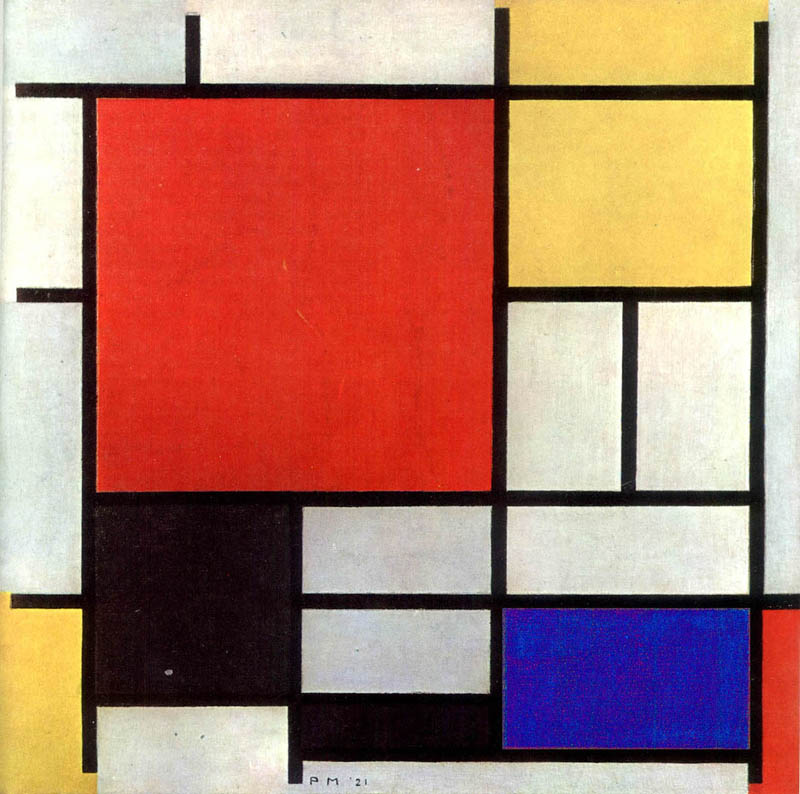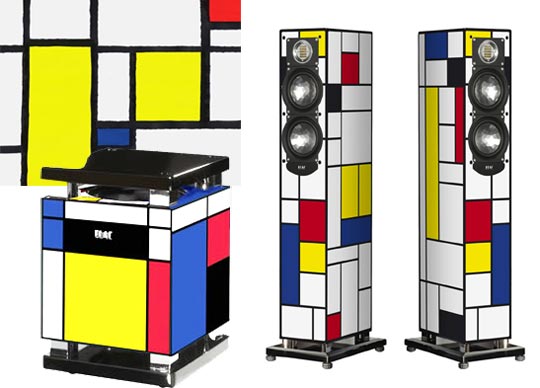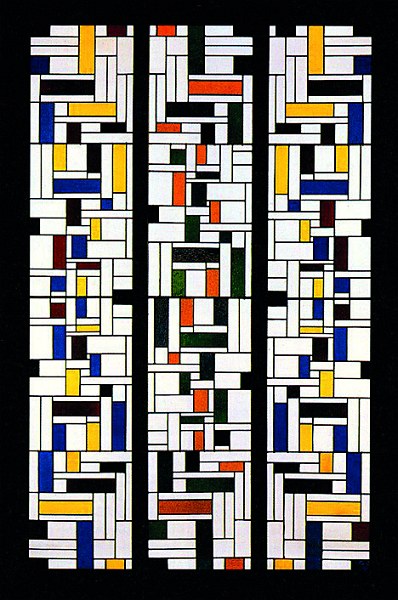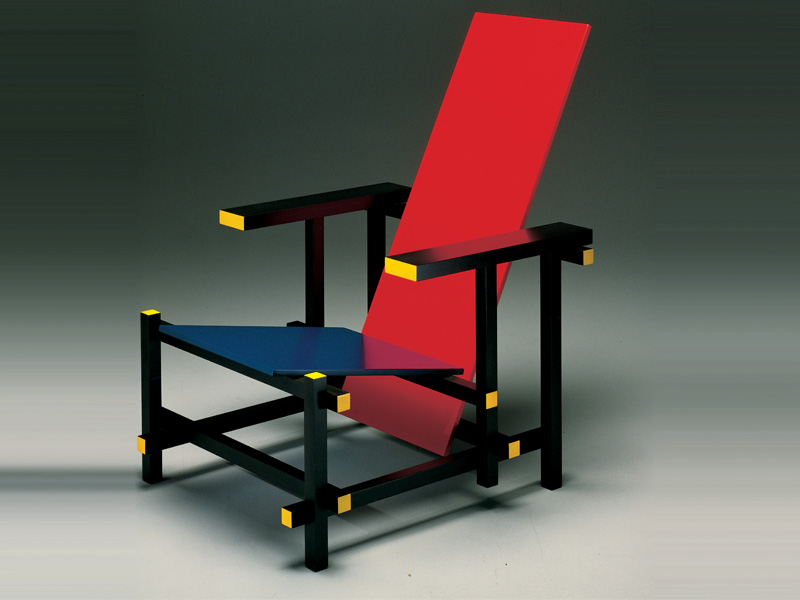Art for Piet Mondrian( 1872-1944) was a cultural product and a cultural weapon, a privileged instrument for the construction of an urban and, in the best sense of the word, artificial order. Yet Mondrian’s perception of the world, no matter how persistent his call for reality , suffered from a curious remoteness. One begins to wonder; if Mondrian is in tune with the world, which world is it that he is in tune with? His much reiterated realism, it would seem, is in fact a form of mysticism.

Evolution. A triptych from 1911. Mondrian uses three female figures to symbololize a mystical progression toward enlightenment. The figure on the left represents matter; that on the right, the soul; and in the center is the open-eyed exalted spirit.
Mondrian was indeed a mystic, and his mysticism amounts to more than an irresponsible use of abstract nouns, or the sprouting of metaphysical generalizations. Much of his life he was committed to theosophy, that fashionable religious doctrine concocted in the late nineteenth century. In 1888 Madame H.P. Blavatsky, the founder of the Theosophical Society, had somberly warned readers of her most famous book, “The Secret Doctrine” , that “all is doubt , negation, iconoclasm and brutal indifference, in our age of the hundred isms and no religion. Every idol is broken save the golden calf”.
The fact that the conclusions of pessimism have been at last assimilated by a certain class of atheistic writers, is a striking feature of the day, and another sign of the times. It illustrates the truism that the void created by modern scientific negation cannot and never can be filled by the cold prospects offered as a solatium to optimists. …If all present sorrow and suffering, the fierce struggle for existence and all its attendant horrors, go for nothing in the long run, if MAN is a mere ephemeron, the sport of blind forces, why assist in the perpetuation of the farce? The “ceaseless grind of matter, force and law,” will but hurry the swarming human millions into eternal oblivion, and ultimately leave no trace or memory of the past, when things return to the nebulosity of the fire-mist, whence they emerged. Terrestrial life is no object in itself. It is overcast with gloom and misery. It does not seem strange, then, that the Soul-blind negationist should prefer the pessimism of Schopenhauer to the baseless optimism of Strauss and his followers, which, in the face of their teachings, reminds one of the animal spirits of a young donkey, after a good meal of thistles. ( Blavatsky )

"Mondrian’s studioThe prime mover of the De Stijl movement was the radically abstract painter Piet Mondrian. He created an entirely human-made reality and his artistic theories, expounded in the magazine, became De Stijl the movement. To Mondrian, red, yellow and blue were the only colours, apart from black and white. Yellow was expansive and vertical, blue the opposite to yellow – soft, retiring, horizontal. Red expressed the radiating movement of life, uniting yellow and blue in an ‘inner’ way, unlike their common mixture, green. Mondrian avoided the use of the colour green, because of its association with nature, and contemporaries recall the painter’s manouverings to avoid having to look out the window at fields or trees. His paintings, with their asymmetrical black lines looked like they were part of a larger environment."
In what they diagnosed as this desperate plight, Blavatsky and her devoted, if sometimes rebellious, followers; Annie Besant, Edouard Schuré, Rudilf Steiner; sought light from an antique tradition of Western mysticism, from mythical figures like Orpheus and Hermes, and from Eastern mystics whose message provided answers that Western seekers could not find in official Christianity or modern atheism. Theosophy promised to still doubts and dispel melancholy.
Theosophy seems a rather paradoxical chice for those, like Mondrian, who professed themselves to be moderns. Its roots were ancient and its ideas alien, its living Asian gurus faced Western culture with blank incomprehension, and its doctrines offered Western man no remedy other than escape. But human nature thrives on paradoxes. It is simply a fact that in the late nineteenth and early twentieth centuries, many apostles of modernism in general loathed the modern world. And many of them such as Vasily Kandinsky, Franz marc, Victor Hugo and William Butler Yeats, embraced esoteric doctrines and enacted spiritualistic rituals that were as hostile to contemporary positivism as they were to existing Christian sects. In the Middle Ages, numerology had been the superstition of the learned; now in the time of Mondrian, theosophy became the superstition of the avant-garde.

"From those crazy Germans who last brought us the Rubik's Cube subwoofer, the De Stijl artwork of Piet Mondrian is the latest source of inspiration for Electroacustic's newest line of speakers and subs..."
Theosophy provided entertainment, reassurance, the excitement normally associated with the uncanny and the occult, and, above all, relief from what struck many sensitive spirits as the unbearable tedium and invincible vulgarity of commercial bourgeois culture. It offered an alternative to materialism. There was a conviction abroad that science, and its ubiquitous companion, technology, had ruthlessly truncated human possibilities, sheering off man’s deepest probes and highest flights to make life flat, two-dimensional. Science had succeeded in exposing Christianity as false, even absurd; this had made official religion intellectually as well as emotionally unavailable.
But science, while performing this necessary act of destruction, had constructed no satisfying substitute. Postivism, the religion of the scientist, was aridit itself; a philosophical desert that offered no shelter from the blazing sun of fact and the icy blast of scientific theory. Science, so the argument went, had given man technical information that few could grasp, creature comforts that only the philistine could enjoy, and a view of the universe vastly indifferent to the happiness, the lot, the very existence of man; a cosmic yawn. In contrast, theosophy restored hope and a sense of mystery, of adventure, of intimacy among the adept.

"Born in 1872, Piet Mondrian was and still is, the most renown artist to propagate the art form of De Stijl, or commonly known as Neo-Plasticism, an artistic movement which derived from the ideals of harmony and order. A focus in the majority of Mondrian’s paintings of horizontal, vertical lines, and primary colors. As a homage to this Dutch master, shoe maker VANS released Modular Authentic, a series of its classic Authentic lace-up based on Mondrian signature painting. Similar to the Nike Dunk Low Premium SB (Mondrian Edition) launched earlier this year, the VANS Modular Authentic also includes the identical bold strokes of black outlines on an all white back
nd, along with interjection of accents in primary colors of yellow, red, and blue."H.P Blavatsky: Theosophy became the basis for many occult societies who borrowed from it … Many members of the Golden Dawn had started out in Theosophy, and it’s teachings seem to have been incorporated into modern day Spiritualism.
The two hundred fifty pound Russian Medium Helena Blavatsky started the Theosophical Society 1875 claiming she had made telepathic contact with mysterious “ascended masters” in Tibet. She dubbed herself a “Priestess of Isis”, and combined Spiritualism, Cabala, Western occultism, Hinduism and Buddhism along with a dash of Darwinian evolution, to make the whole thing sound “scientific”. …
The Theosophical Society had an alliance with an organization run by a certain Swami Sarasvati, until the Swami denounced Blavatsky and her sidekick Ollcott as charlatans , and they were exposed as such many times. She wrote two occult best sellers, Isis Unveiled (1887) and The Secret Doctrine (1888), which are still in print. Blavatsky claimed the ascended masters inspired her to write the books and communicated with her telepathically. She claimed the goddess Isis herself gave her the ideas for Isis Unveiled. There’s actually no real evidence she actually had any contact with “ascended masters” or “Isis”, and the bulk of the material for her books is simply plagiarized from other works.

"Golden Rectangle Piet Mondrian was a Dutch painter, a pioneer of Geometric abstraction. New York City (1941-42) Oil on canvas 119 x 114 cm (46 7/8 x 44 7/8 in) Musee national d'art moderne, Centre Georges Pompidou, Paris. In the further attempt to simplify and perfect his images, he did not use any curved lines or organic shapes, he used only straight lines and geometric shapes. He also only used black, white, gray, and the three primary colors – bright red, blue, and yellow. The use of his simple geometric shapes and basic colors formed a new style or art movement called De Stijl. "
…What made theosophy so peculiarly seductive was that it committed its devotees to nothing decisive. Being itself the most confused of eclectic compilations, theosophy legitimated confusion; it licensed the faithful to hold beliefs that a more demanding theology or more rigorous metaphysics would have exposed as quite simply, inconsistent and incoherent, or a least compellingly and comprehensively incoherent. Theosophy was the proverbial buffet table that had something for everyone and any budget, almost as though Madame Blavatsky had put her doctrines together after consulting opinion polls and focus group interviews.
Theosophy was in no way an isolated phenomenon. Like the concurrent streams of aestheticism, symbolism, and romantic Catholicism, theosophy reflected a value-impregnated dualism. It differentiated sharply between two worlds; on the one side, there was business, science, “mundane” styles like realism and impressionism; on the other, the world “behind the mask”. The world of lofty contemplation, of disdainful distance from common pleasure seekers and philistine patrons. And, different, even incompatible, as they were, all these movements offered the same sort of ladder from the vulgar to the purer world; allusion, symbol, legend, mystical correspondences, and esoteric rites. …

"The car is also listed with ArtCarAgency.com as the “Mondrian Mobile.” Piet Mondrian was a Dutch artist in the De Stijl movement, whose style was typified by blocks of primary colors (and black and white) separated by thick, black lines."
“A skeptic named William Coleman discovered 2000 passages Blavatsky lifted from other books and never gave credit for. He counted a total of 100 books in all used in the making of Isis Unveiled, and The Secret Doctrine was discovered to be in a similar vein, with even entire pages plagiarized from other books! The footnotes to Blavastky’s books were added years after her death by her followers to help cover up her plagiarism. The Stanzas of Dyzan, yet another book Blavatsky wrote, claiming it was the oldest book in the world, also turned out to be a hoax with many passages copied from books of the 19th century!
Blavatsky was born of Russian nobility. She married a 50 year old Colonel, but soon left him. She is said to have had several odd jobs, including a trick rider in a circus, a piano teacher, and manager of an artificial flower factory. She also became the traveling companion of a wealthy heiress who had a library of hundreds of books that she always took with her. This is no doubt where Blavatsky got much of her material to plagiarize from.”

"The best known contributor to this movement is undoubtedly Mondrian, who is part of the Tremendously Famous Triumvirate of Dutch painting (the other two triumviri being Rembrandt and Van Gogh). De Stijl itself owes much of its acclaim to his Rubik cube-like 'Neo-Plasticist' paintings and of course also to the Red and Blue Chair designed by Gerrit Rietveld in 1917. Incidentally, speaking of renown, the White Stripes' album 'De Stijl' (2000) was dedicated to furniture designer Rietveld, thus proclaiming the minimalist and deconstructionist aspects of the movement's priciples of design as a source of inspiration for their own musical image and presentation."
…The appeal of such notions to artists is obvious enough: to exalt the spirit is to exalt the artist, its guardian. To make religion into an art is to invite the heady reversal of making art into a religion. “Art”, wrote Mondrian in 1917, ” …hoever much an end it itself… is, just like religion, a means by which the universal is known.” And, “art already can provide a transition to the finer regions, which I call the spiritual realm.”Art is “the path of ascension; away from matter.”
The strange triptych he painted about 1911, “Evolution” , demonstrates that for Mondrian, at least, philosophy meant theosophy. The magical number three that dominates the work, the aseptic sexuality of the three women, the occult emblems that accompany them, the spiritual progrssion marked by the opened eyes of the figure in the center, the very theme of illumination and spiritual growth underscored by the theosophical title; all these are unthinkable without the writings of Madame Blavatsky and Rudolf Steiner….

"This map of Leyden, in the style of De Stijl, was made by Jos Agasi in 2007, the 90th anniversary year of the movement’s founding. “The map was originally made for a project by RAP Architectuurcentrum here in Leyden,” writes Mr Agasi. “In 2008, together with Sanne Dresmé, I organised the project `U bevindt zich hier – Een reis door Leiden in 80 kaarten` (`You are here – A voyage through Leyden in 80 maps`). That project also featured this De Stijl map, which I subtitled: `Design for a stained glass window in Leyden city hall`, hoping the city might find it a nice idea. I made a sketch on my site of how it would look. Who knows, one day it will come true.” “I was inspired by works by Theo van Doesburg, who lived in Leyden from 1916 to 1920. "
“As previously mentioned, for a time she was the assistant to medium Daniel Home, and this is where she learned the tricks of the trade of Spiritualism. She was not as cautious as Home, however, and got accused of fraud and exposed as a fake several times during her career. She set up shop as a medium in Cairo, Egypt, but was exposed as a fake when someone found a long white glove stuffed with cotton in the Seance room right before a Seance was about to begin … Blavatsky decided she needed a better scam than Spiritualism. At first they called it The Miracle Club, but it didn’t take, since it was too much like Spiritualism. Then she decided on the name Theosophy, and the scam worked. Once she claimed to have materialized a teacup by meditating while sitting on the ground. When an observer accused of her of having buried it there earlier and merely digging up the teacup, she was treated to one of those blasts of foul language Blavatsky was notorious for.
One follower (who had apparently been Blavatsky’s assistant in fakery) named Emma Coulomb became disillusioned with Blavatsky and set out to expose Blavatsky as the fraud she was. Coulomb passed along evidence which showed Blavatsky to be a fake to the editor of Christian College Magazine. One revelation was that Blavatsky made letters from “Coot Hoomi” (one of the Tibetan ascended masters Blavatsky supposedly had contact with) seem to magically appear from nowhere by simply shoving them through cracks in the ceiling from the room above! Coulomb also revealed Blavatsky had secret passages and hidden doors built into her house which aided her in deceiving people about her “psychic abilities”. Why did she do this? Well, it’s because she was a fraud and she had no powers and people who follow her teachings today need to accept this.”

"Theo van Doesburg Stained-Glass Composition IV, stained-glass window in three parts for the hall, designs for the interior and exterior of the De Lange House, Alkmaar 1918 Kröller-Müller Museum, Otterlo"
…For Steiner, and his fellow prophets, man is threefold: he lives through, in the ascending order of their purity, his body, his soul, and his spirit. His first environment, as Steiner graphically put it, includes “the objects, intelligence of which flows into him through the gates f his senses, which he touches, smells, tastes, hears and sees.”
The second, that of the soul, consists of the impressions these objects make on him, his pleasures and pains, his desires and aversions. The third is on a far higher level; here, in the dazzling light of knowledge and insight, where the secrets of the body and soul are laid bare, man’s godlike essence emerges. “Man,” Stainer sums up, “is the citizen of three worlds.”

"When Dutch furniture designer Gerrit Reitveld designed the Red Blue Chair in 1918, he wanted to create a piece that used common dimensions of lumber and could be mass-produced. The focus was not on comfort but on the logical and simplistic design. To this day his chair exemplifies functionalism as well as the de Stijl movement (i.e. Piet Mondrian)."
“About this same time The Society for Psychical Research set out to India to investigate Blavatsky at the insistence of Coulomb. The investigator, Richard Hodgson, was admitted to the room containing the “shrine” where Coot Hoomi’s letters magically appeared, but only after much stalling. He smelt a rat after finding just a newly made cedar wood box and freshly plastered walls. A bungling follower tried to defend HPB by saying “You see, it’s perfectly solid” while slapping the back of the “shrine”, and thus accidentally causing the back to fall off, revealing a secret entrance to Blavatsky’s bedroom!…

""Many of your pieces completed between 1986 and 1990 make their point by means of a dialogue with works from the heroic phase of modernism (fig. 10) in the 1920's, particularly those of artists like Mondrian or Rietveld from the Dutch De Stijl movement. Now, it seems to me that there are at least two things going on here. One is the post-modern phenomenon of a recycling of earlier styles; your work has already been linked by critics with what has come to be called 'appropriation art.' The other is your specific interest in Dutch modernism. Let's take the last one first. You are Dutch by birth, you worked in Amsterdam in the seventies, and you have been back here almost on a yearly basis through the past decade. This, along with your orientation to De Stijl, points to a question of 'roots.'"
The Society for Psychical Research published a detailed 200 page report, detailing the methods of trickery Blavatsky used. The report concluded by calling her “…one of the most accomplished, ingenious, and interesting imposters in history”. Her society sounds as though it was actually a cult. Many of her closest followers were said to have suffered miserable fates, including suicide. Biographer Gertrude Williams wrote that “she ruled her followers ambidextrously, through glamour and fear”.

Van Doesburg."... they developed two differing creative approaches to non-figurative art. Some works use a physical object or form as a starting point, whether a card-player, seated woman, or cow for van Doesburg, or a working men’s procession for Bart van der Leck. The component parts of the object are pared down, and recomposed as a geometric framework. By anchoring the abstract image in external reality, this approach avoided the pitfall of decoration for decoration’s sake."
Blavatsky’s Theosophy deals with such hookum as the “seven root races”. The god like giant Aryan race lived on Atlantis and lost their god-like status by intermarrying with the “semi-human” Jews. The intermarrying with Jews caused the Aryans to devolve, according to Blavatsky. Blavatsky called Judaism a “religion of hate and malice toward everyone and everything outside itself.” , while the Aryans were the most advanced people spiritually. Compare this type of mentality with that of Joseph Mengele. Theosphy is nothing but recycled occult gobbledy gook from previous books with a strong flavor of anti-Semitism and anti-Christianism thrown in for flavor!

Van Doesburg. "The second option proceeds in the reverse direction. It consists of devising or adopting an organised system of lines, forms or colours and generating variations based on repetition, rotation, or reflection. In this creative process, any object notionally depicted is conceived of as an ornamental motif. In van Doesburg’s stained glass, for example, an abstract version of a seated woman or a skater morphs into a module which is multiplied and flipped in every direction to generate an overall design. Soon Mondrian was transcending even this alternative with pictures that were no longer abstractions of perceived reality, but independent compositions, metaphorical representations of the harmony of the world. "
Her saddest and most horrifying accomplishment was being the spiritual impetus for the Nazi regime, decades after her death. As you can guess by her doctrines about Aryans and Jews previously mentioned, many German occultists and racists embraced Blavatsky’s idea of being descended from Aryan god-men and her anti-Semeticism. Blatvatsky’s favorite occult symbol was the swastika, which she claimed was the symbol of the Aryan race and the most powerful of all occult symbols. This symbol was adopted by the Nazis. Heinrich Himmler was a devout believer in Blavatsky’s teachings, and even went on an expedition to Asia as Germany was losing WWII to try and find the (non-existing) link to the Tibetans and the Aryans. … Blavatsky helped in part create the holocaust. Her racist doctrines are more than just pure fantasy, they are also pure evil.”





 COMMENTS
COMMENTS
The term Hinduism also occurs sporadically in Sanskrit texts such as the later Rajataranginis of Kashmir (Hinduka, c. 1450), some 16th-18th century Bengali Gaudiya Vaishnava texts, including Chaitanya Charitamrita and Chaitanya Bhagavata, usually to contrast Hindus with Yavanas or Mlecchas.;*;;
http://www.caramoan.ph
Please do pay a visit to our webpage